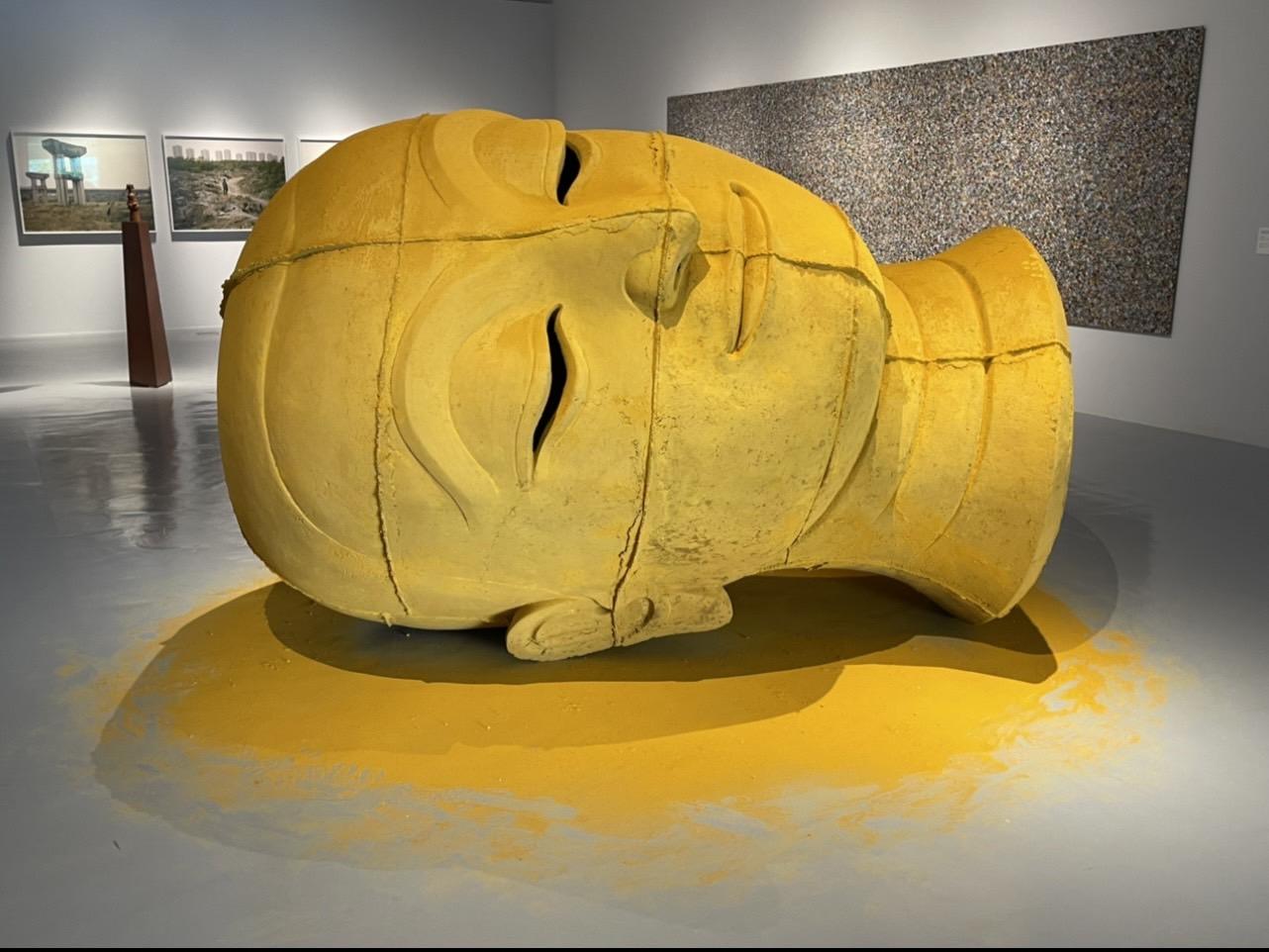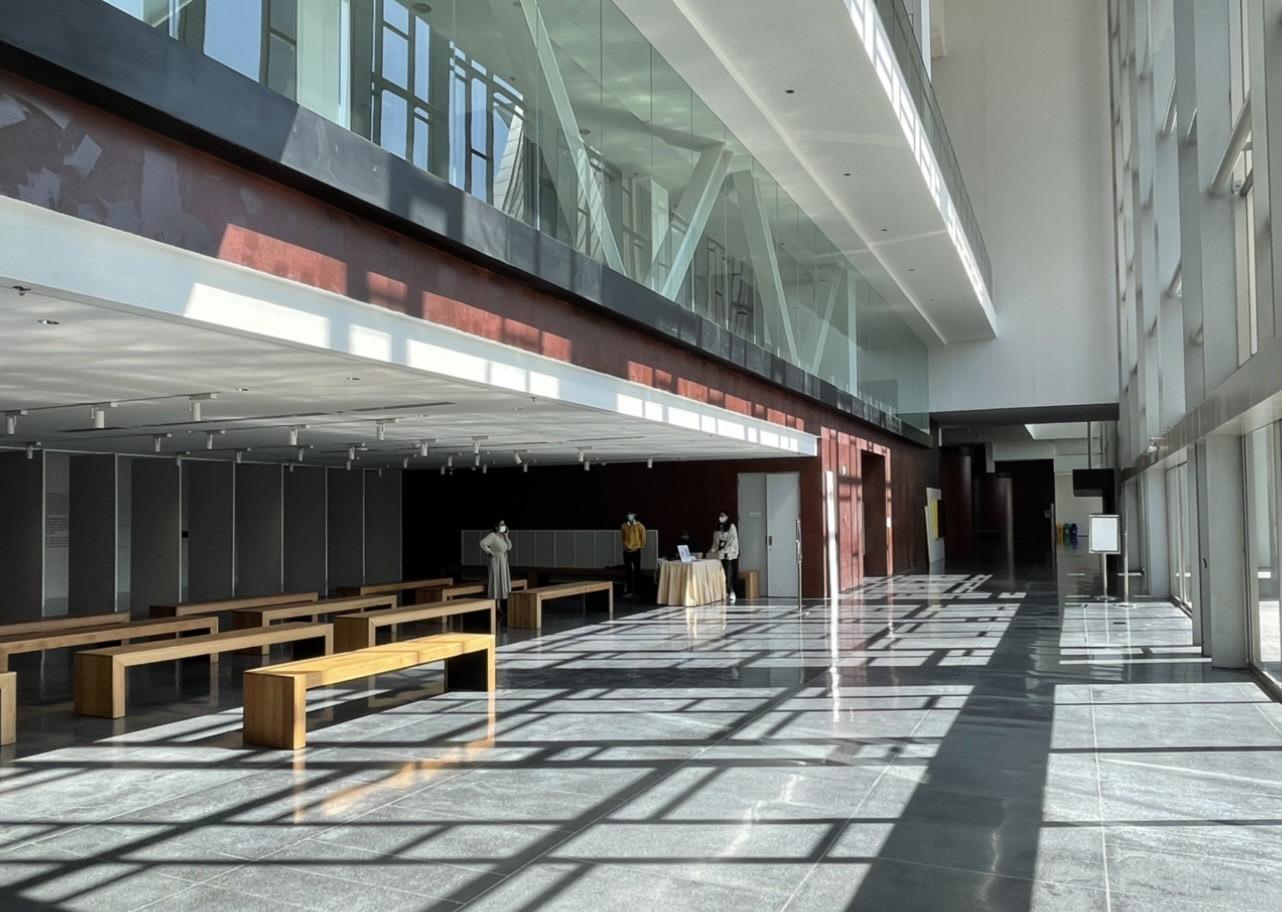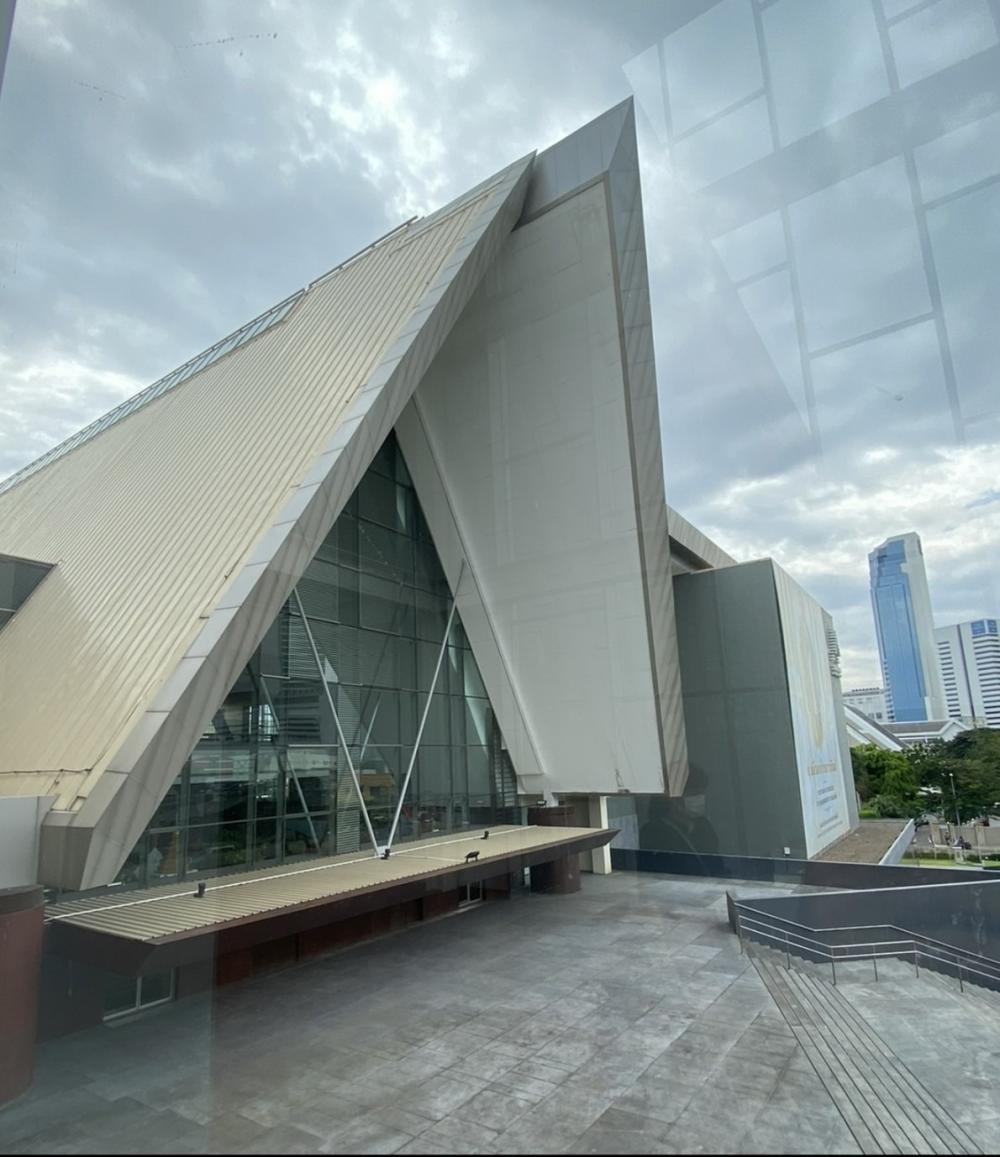
On Thiam Ruam Mit Road, Huai Khwang, a huge and empty building with a triangular façade has stood for years. A big plaque on the lawn in Thai translates to The National Gallery of Art. With no activities inside, people are left wondering when it will open. Is it true that there are plans to convert it into mixed-use spaces instead of a display of national treasures of modern and contemporary Thai art?
During the Thaksin Shinawatra government in 2003, a grandiose megaproject began on the purchased land next to Thailand Cultural Centre. Envisaged as Asean Cultural Gateway, the complex consisting of the Ministry of Culture, National Art Gallery, Concert Hall, Theatre and Digital Library was planned to be similar to the Beaubourg area in Paris. The design contest in 2005 attracted many entries including Casa Company, Architect 49, Sumet Jumsai Associates plus 3D, Duangrit Bunnag Architect, and Robert G. Boughey and Associates.
With an innovative proposal by Nithi Sthapitanonda's Architect 49 selected as the winner, there was excitement and anticipation that Bangkok was ready to be one of the leading cultural centres in the region. Architect 49's design plan was outstanding with state-of-the-art technology and features that connect with Thailand Cultural Centre and MCOT. The design of the National Art Gallery was inspired by the Thai numerical number nine, the symbol of King Rama IX.
In 2006, when Thaksin was overthrown by a military coup, the junta government intervened in the building design. The Ministry of Culture ordered Architect 49 to change the façade of the National Art Gallery so that it would have more Thai characteristics.
National Artist Nithi said in an interview: "It was a pity that the Ministry of Culture decided to change the original design that was meant to celebrate King Bhumibol Adulyadej's 60th anniversary on the throne and pay tribute to His Majesty as artist and musician. Ironically, the Ministry of Culture informed that it wanted to have a façade with a triangular form so it would look more Thai." This was a period of intense regression as Khunying Khaisri Sri-Aroon, Minister of Culture, became the staunch defender of Thainess through ultraconservative policy and censorship. Scenes in performances and films were censored. Khaisri herself led programmes on proper dress code, etiquette and the Thai language. She went as far as imposing strict controls on coyote dancers and video game shops near schools and temples. Subsequently, as cultural policy shifted from creativity and open-mindedness to jingoism and nationalism, preparation for a rich and innovative cultural centre suffered enormously.

Instead of learning about success stories of institutions like the National Gallery Singapore in exhibition programmes and investing in human resources, the steering committee opted for safe policies that served the national ideology of nation, religion and king. They gave little interest in training curators and staff in contemporary art. In fact, the budget of over 1 billion baht on the National Art Gallery was allotted for construction and interior designs while a minimum amount was given to curatorial training, research and acquisition of modern and contemporary Thai art.
Over a period of 14 years, the construction of the cultural complex went through stages of adaptation due to budget cuts. Priority was given to ministry office buildings while the Concert Hall, Theatre and Digital Library were put on hold. The National Art Gallery suffered a series of delays due to change of contractors and internal rifts among ministerial senior staff.
After the coup in 2016 that overthrew the Yingluck government, the junta under Gen Prayut Chan-o-cha had little interest in the preparation of human resources essential for policy related to the creative economy and soft power. The National Art Gallery faced more obstacles due to cheap building materials that caused leakages and flooding inside galleries. Interiors and floors had to be refurbished before the National Art Gallery could open to the public. The triangular façade that endured sun, rain and pollution for so many years deteriorated with cracks and peeling paint. Sadly, it looked worn out and badly in need of a facelift.
Walking inside the spacious galleries that have been left empty for over two years due to lack of budget gave a feeling of hollowness and void. The disgruntled junior staff of the Office of Contemporary Art and Culture (OCAC) received little direction and guidance on the preparation of the exhibition programme, collection policy and curatorial practice. Signs of frustration and disappointment were clearly evident. Last year, however, the 2022 Acquisitions Exhibition at the National Art Gallery by 16 artists with 79 artworks including Apichatpong Weerasethakul, Arin Rungjang, Imhathai Suwatthanasip, Jakapan Vilasineekul, Dusadee Huntrakul, Mit Jai-In, Thasanai Sethaseri and Sakarin Krua-On was briefly put on display. OCAC announced that it gathered a national collection of contemporary art by Thai artists consisting of over 500 works. There was a feeling of optimism that the audience would see some of these works. Surprisingly, after only three weeks the exhibition closed down due to lack of funds for electricity and air conditioning.

When asked about the depletion of annual funding, Prasop Riengnern, director-general of OCAC, said: "We only had that much funding for that length of time, so we had to close down the exhibition." As for the future, Prasop gave a pessimistic view. "We have zero budget for the National Art Gallery next year as it is under the responsibility of the Permanent Secretary Office." This leads to the question as to why OCAC, which is the department responsible for contemporary art, has no budget to run the National Art Gallery.
In 2021, the Ministry of Culture held a soft opening on the lawn of the cultural complex with a display of colourful Hindu deities along with a group of canine sculptures by Wasinburee Supanichvoraparch. The latter was fun and humorous and attracted plenty of attention from the public, notably a cute puppy lifting his hind leg to pee in front of the Ministry of Culture. Since then, apart from occasional outdoor concerts, nothing much happens at this vast cultural complex. Disappointingly, the so-called Asean Cultural Gateway branded as Thaksin's brainchild has not lived up to expectations. Whatever went wrong?
Yupa Thaweewathanakitbawon, Permanent Secretary of the Minister of Culture, said her office is looking after next year's National Art Gallery annual budget. "There is much to be done due to repair and renovation of the National Art Gallery," she said. "After that, we hope to officially open the National Art Gallery in time to celebrate King Vajiralongkorn's 72nd birthday. We will show only works by Thai artists and no international artists."
Unfortunately, the future of the National Art Gallery looks bleak. Without strategic plans and art calendars, the building is left empty. Some spaces are used for press conferences, fashion displays and cultural products from provinces. Instead of a display of artworks, sections have been converted into exercise areas with treadmills for civil servants. Clearly, the intention has shifted from an exhibition of permanent modern and contemporary Thai art to multi-purpose services including Buddhist ceremonies by the Department of Religious Affairs and seminars by the Thai Media Fund.

In 2019, towards the end of Prayut's junta government, the Ministry of Culture interfered again with the masterplan of Architect 49 by scrapping its original design for the Concert Hall, Theatre and Digital Library to announce a new design contest. Done in haste, the competition was criticised for lack of transparency as there were just two entries for the 3 billion baht megaproject. The winner went to Span Engineering Consultant, an engineering company that has no experience in architectural and interior design for acoustics, stage and theatre. Looking like an imitation of Herzog & de Mueron's Bird's Nest stadium in Beijing, the design by Span Engineering seems out of place and context for Bangkok's cultural complex. When asked about the new design for the second phase of the Concert Hall, Theatre and Cultural Knowledge Center, Yupa said that the project has not progressed due to Covid-19. Instead priority will be given to the building of the Royal Sponsored Funeral Service Division of the Department of Religious Affairs. The addition of this building was not in the original plan of the cultural complex.
Nithi and Architect 49 endured interference by both the junta governments under Surayud Chulanont and Prayut. Nithi bemoaned that it was incomprehensible why his design for the Concert Hall, Theatre and Digital Library which had won the contest was annulled. Such a predicament points to the fact that like the National Art Gallery further delays and mismanagement will waste more time and funding. Without direction and clear vision, the complex will face constant pressure with pressing questions.

When will the National Art Gallery open to the public? Why are there no exhibition plans and art calendars? Why is it exclusively for Thai art exhibitions? How to prevent national treasures from becoming national trash due to below-standard storage, humidity and temperature control? Why are there no funds to turn on electricity and air conditioning? When will Thailand have a permanent exhibition that properly displays masterpieces of modern and contemporary Thai art? With so much tax money down the drain due to mismanagement, this project has been criticised as a failure and nothing short of a national disgrace.
With recent debate by political parties on the revamp of the Ministry of Culture after the election, it is indeed time to evaluate if this ministry can truly contribute in terms of the creative economy. We must realise that the Ministry of Culture's main mission is about the preservation of tradition, culture, religion and art. The promotion of Thai identity is intrinsic to the national image and essential for national propaganda like when it was founded by Plaek Phibunsongkhram in 1952. Civil servants and veterans dressed up in Thai costumes and performing traditional dances on stage may fall under the category of soft power. However, for the Ministry of Culture to become a driving force in the creative economy, the outdated mindset of those responsible must change drastically. The soft veneer of a Thai smile and joie de vivre is simply not enough. Sadly, the soft underbelly of the Ministry of Culture is its ultraconservative stance and resistance to change.








